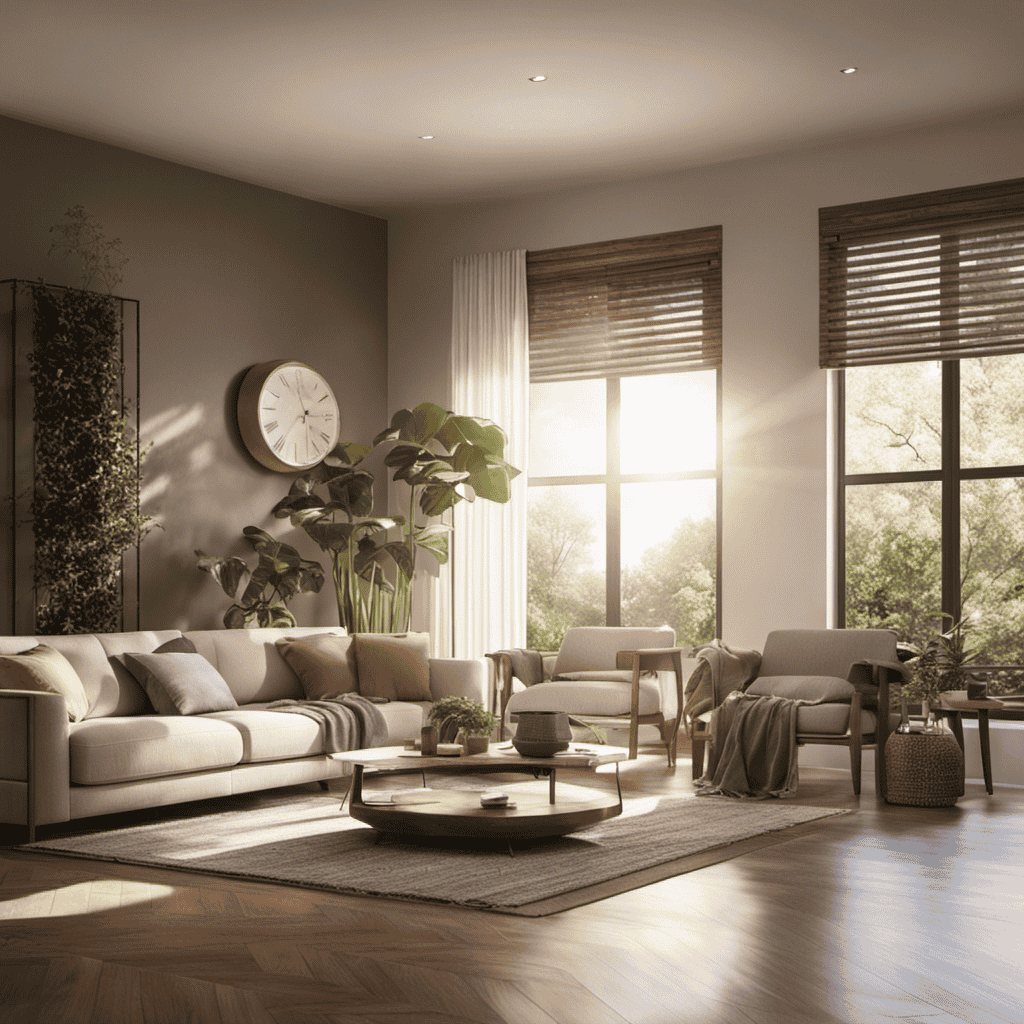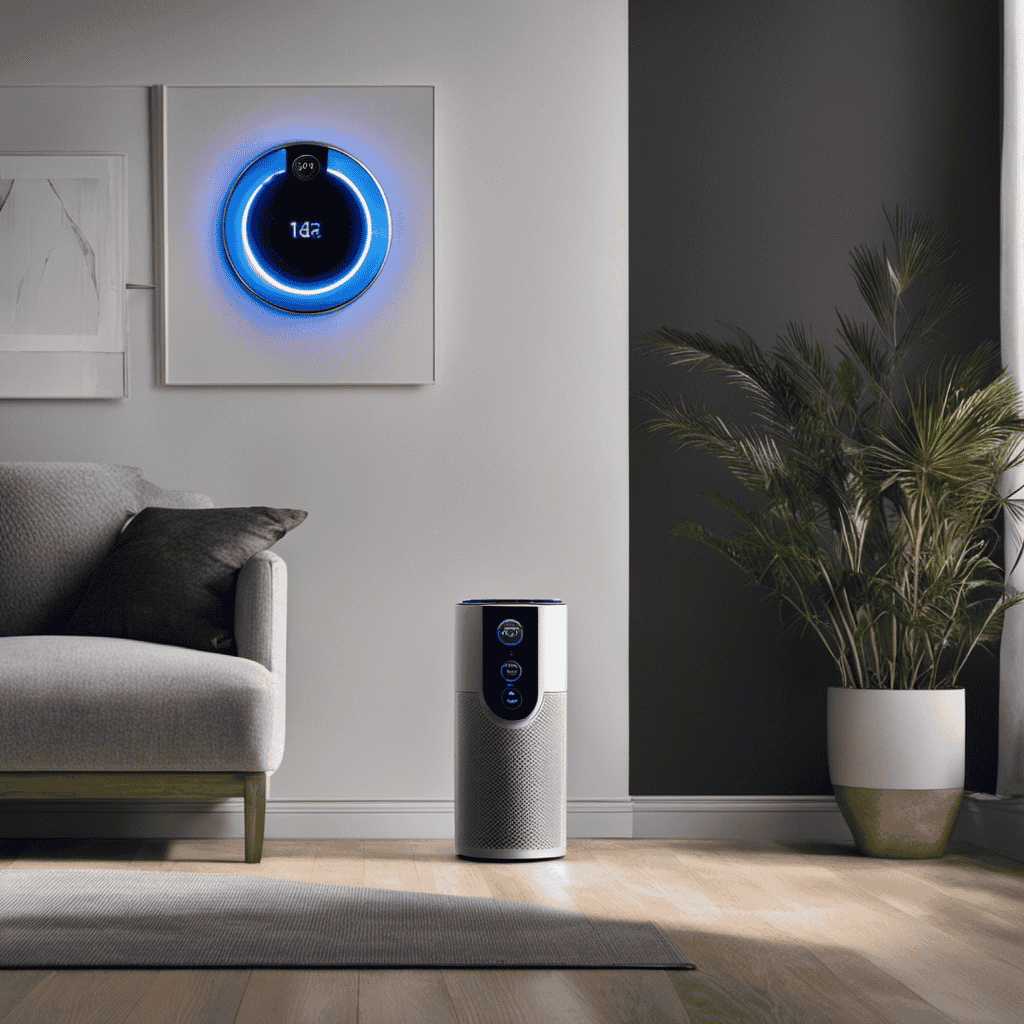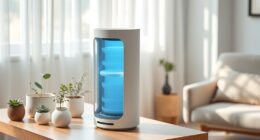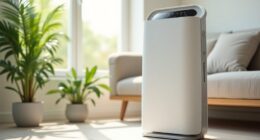I really enjoy breathing in clean, fresh air while I sleep. Therefore, I believed that using an air purifier in my bedroom would be the ideal solution.
However, after some research, I was surprised to discover that there are actually some compelling reasons to avoid using an air purifier in the bedroom.
In this article, I will explore the potential risks, discuss alternatives, and debunk common myths surrounding air purifiers in the bedroom.
It’s time to separate fact from fiction and make an informed decision.
Key Takeaways
- Emission of ozone from air purifiers can cause respiratory irritation and worsen asthma symptoms.
- Certain air purifiers may produce harmful byproducts such as formaldehyde or other volatile organic compounds (VOCs).
- Use air purifiers with low or no ozone emissions and activated carbon filters to remove VOCs.
- Consider alternatives such as using indoor plants, increasing ventilation, and maintaining a clean environment to improve air quality in the bedroom.
5 Reasons to Avoid an Air Purifier in the Bedroom
There are a few reasons why you might want to avoid putting an air purifier in the bedroom. While air purifiers are commonly used to improve indoor air quality, they can have negative effects on our health if not used properly.
One of the main concerns is the emission of ozone, a gas that can cause respiratory irritation and worsen asthma symptoms. Some air purifiers generate ozone as a byproduct, especially those that use ionization technology.
Additionally, certain air purifiers may produce harmful byproducts such as formaldehyde or other volatile organic compounds (VOCs). These substances can have adverse health effects, including eye and throat irritation, headaches, and even long-term health consequences.
Therefore, it is important to carefully choose an air purifier that does not emit ozone or other harmful substances, especially if it will be used in the bedroom where we spend a significant amount of time.
The Potential Risks of Using an Air Purifier in the Bedroom
To minimize potential risks, it’s important to consider the impact of using an air purifier in your bedroom. While there are benefits to having clean air in the bedroom, it is crucial to understand the potential risks associated with using an air purifier. Here are some key factors to consider:
| Potential Risks | Precautions |
|---|---|
| Ozone emission | Choose an air purifier with low or no ozone emissions. |
| Noise pollution | Look for air purifiers with noise reduction technology. |
| Allergies and asthma | Opt for HEPA filters to effectively remove allergens and asthma triggers. |
| Chemical sensitivity | Select air purifiers with activated carbon filters to remove volatile organic compounds (VOCs). |
| Maintenance and cost | Regularly clean and replace filters to ensure optimal performance. Consider the long-term costs of filter replacements. |
Alternatives to Using an Air Purifier in the Bedroom
Consider exploring other options for improving air quality in your bedroom. While air purifiers can be effective in removing pollutants from the air, there are alternative solutions that are more natural and can provide similar benefits.
Here are three natural ways to improve air quality in your bedroom:
-
Use indoor plants: Certain plants, such as aloe vera, spider plant, and peace lily, have air purifying properties and can help remove toxins from the air.
-
Increase ventilation: Opening windows or using fans can help circulate fresh air and reduce the concentration of indoor pollutants.
-
Keep a clean environment: Regularly dusting, vacuuming, and keeping your bedroom clutter-free can help minimize the accumulation of dust, allergens, and other pollutants.
How Air Purifiers Can Affect Sleep Quality in the Bedroom
Using an air purifier in the bedroom can improve sleep quality. It reduces the presence of allergens and pollutants in the air, such as dust, pet dander, pollen, and mold spores. These particles can trigger allergies and respiratory issues. By removing irritants from the air, air purifiers create a cleaner and healthier sleeping environment.
Air purifiers also reduce odors, like smoke or cooking smells, ensuring a more pleasant sleeping experience. However, it’s important to consider the noise levels of air purifiers. Some models can produce noticeable noise, which may disrupt sleep for light sleepers. To avoid this, choose a model with a comfortable noise level.
Now, let’s debunk some common myths about air purifiers in the bedroom.
Debunking Common Myths About Air Purifiers in the Bedroom
You may be surprised to learn that some misconceptions about air purifiers in the bedroom can actually hinder your sleep quality. Contrary to popular belief, air purifiers can have a positive impact on your sleep environment. Here are three important facts to consider:
-
Air purifiers effectively remove airborne pollutants such as dust, pollen, and pet dander, which can trigger allergies and respiratory issues. Breathing clean air can help improve sleep quality and reduce nighttime congestion.
-
Clean air promotes better overall health. Air purifiers can eliminate harmful particles, bacteria, and viruses, creating a healthier bedroom environment. This can reduce the risk of respiratory infections and promote better immune function.
-
Air purifiers can help reduce odors and improve air circulation, creating a more pleasant and comfortable sleeping environment. This can contribute to a more restful sleep and enhance overall sleep quality.
Conclusion
In conclusion, it’s wise to weigh the pros and cons before placing an air purifier in your bedroom. While it may seem sensible for improving air quality, there are potential risks involved. Alternatives, like keeping your bedroom clean and well-ventilated, can also positively impact air quality.
Furthermore, studies have shown that air purifiers can affect sleep quality. So, it’s important to consider other factors that contribute to a restful night’s sleep. Ultimately, make an informed decision based on scientific evidence and expert advice.










